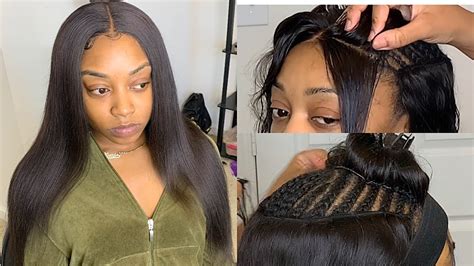Introduction
Closure sew-ins have emerged as popular hair extensions techniques, empowering individuals to achieve versatile and natural-looking transformations. This comprehensive guide explores the intricacies of closure sew-ins, including their advantages, drawbacks, common mistakes to avoid, and essential considerations for embracing this transformative hair styling option.

What is a Closure Sew In?
A closure sew-in is a hair extension method that involves sewing a closure piece, typically made of lace or silk, to the natural hair. The closure serves as a base for the extensions, providing a seamless and undetectable transition between the natural hair and the extensions.
Types of Closure Sew-Ins
1. Lace Closure Sew-In:
- Uses a lace closure to create a natural-looking scalp effect
- Provides versatility in styling options
- Can last for 3-6 weeks with proper maintenance
2. Silk Closure Sew-In:
- Uses a silk closure for a more durable and tangle-resistant option
- Offers a smooth and shiny appearance
- Can last for 6-8 weeks with proper care
Benefits of Closure Sew-Ins
- Versatility: Closure sew-ins allow for endless styling options, including ponytails, buns, braids, and curls.
- Protective Style: Sew-ins protect natural hair from heat damage, breakage, and split ends.
- Length and Volume: Extensions add length and volume to thin or short hair, enhancing the desired fullness and thickness.
- Low Maintenance: Sew-ins require minimal maintenance compared to other extension methods.
Drawbacks of Closure Sew-Ins
- Cost: Closure sew-ins can be more expensive than other extension methods.
- Installation Time: The installation process can be time-consuming, typically taking 2-4 hours.
- Scalp Tension: Tight sew-ins can cause scalp tension and discomfort.
- Limited Lifespan: Sew-ins typically last for 4-8 weeks and require regular maintenance to maintain their appearance.
Common Mistakes to Avoid
- Over-Tightening: Avoid pulling the closure too tightly, as this can cause scalp pain and even hair loss.
- Insufficient Aftercare: Neglecting proper maintenance can lead to tangling, matting, and premature wear.
- Using the Wrong Hair Type: Selecting extensions that do not match the natural hair texture or color can result in an unnatural appearance.
- Improper Installation: Attempting to install a closure sew-in without professional guidance can lead to poor results and damage to the natural hair.
Why Closure Sew-Ins Matter
Closure sew-ins empower individuals to achieve their desired hair goals, regardless of their natural hair texture or density. By providing versatility, protection, and enhanced aesthetics, sew-ins have transformed the hair extension industry.
How to Choose the Right Closure Sew-In
1. Determine the Closure Type: Consider the desired scalp effect and durability when selecting a lace or silk closure.
2. Choose Extension Length and Texture: Match the length and texture of the extensions to complement the natural hair, ensuring a seamless transition.
3. Select a Qualified Stylist: Opt for a seasoned hairstylist with experience in closure sew-ins to minimize risks and ensure a satisfactory outcome.
Tips for Maintaining Closure Sew-Ins
- Gentle Washing: Wash the sew-in every 1-2 weeks with sulfate-free shampoo and conditioner.
- Detangling: Use a wide-toothed comb to gently detangle the hair while it is wet.
- Deep Conditioning: Deep condition the extensions every 2-3 weeks to restore moisture and maintain their smoothness.
- Protective Styling: Wear a silk scarf or bonnet at night to prevent tangling and friction.
Closure Sew-In vs. Other Extension Methods
| Closure Sew-In | Glue-In Extensions | Tape-In Extensions | Micro-Ring Extensions |
|---|---|---|---|
| Requires sewing the closure to hair | Adheres extensions using glue | Attaches extensions with tape | Secures extensions using small metal rings |
| More durable | Less durable | Less durable | Less durable |
| Provides a more natural scalp effect | May leave glue residue on hair | Can be visible through fine hair | Requires special equipment for installation |
| More time-consuming to install | Less time-consuming to install | Less time-consuming to install | More time-consuming to install |
Conclusion
Closure sew-ins have revolutionized the world of hair extensions with their ability to enhance length, volume, and versatility while protecting the natural hair. By addressing common mistakes, selecting the right sew-in, and following proper maintenance techniques, individuals can embrace the transformative power of closure sew-ins and achieve their hair goals effectively and stylishly.
